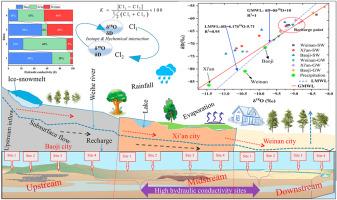关中盆地地表水和地下水的水化学和稳定同位素分析:对理解它们相互作用的意义
IF 4.1
3区 地球科学
Q2 GEOSCIENCES, MULTIDISCIPLINARY
引用次数: 0
摘要
可持续地管理水资源需要全面掌握地表水与地下水的相互作用,以维持健康的生态系统。通过水化学及地表水和地下水的稳定同位素(δD和δ18O)研究了关中盆地(中国西北典型的半湿润大陆性季风区)地表水和地下水的相互作用。2022年,共有27个监测点在目标城市(渭南、西安和宝鸡)取样。区域地表水化学特征和地下水水化学特征具有明显的空间分布规律。HCO3-Ca·Mg水化学类型在地表水和地下水中最为普遍。宝鸡、西安和渭南3个站点的水力连通性分布差异显著,其中渭南在站点1和站点2、西安在站点3、宝鸡在站点4表现出优势的高连通性。这种空间格局突出了由特定地点的水力特性控制的独特水文地质特征,反映了地下性质的局部差异。宝鸡、西安和渭南地下水补给的主要来源分别是降水(17%、68%和15%)、地表水(50%、41%和9%)和上游来水(52%、40%和8%)。水化学和同位素综合结果显示了地表水和地下水相互作用的空间变异性。这些研究结果为该地区地下水与地表水相互作用的综合管理提供了有力的科学依据。本文章由计算机程序翻译,如有差异,请以英文原文为准。

Hydrochemical and stable isotopic analysis of surface water and groundwater in the Guanzhong Basin, China: Implication to understanding their interactions
Managing water resources sustainably requires a thorough grasp of surface-groundwater interactions to maintain healthy ecosystems. This study investigated surface water-groundwater interactions in the Guanzhong Basin, a typical semi-humid continental monsoon region in Northwest China, by examining hydrochemistry and stable isotopes (δD and δ18O) of surface water and groundwater. A total of 27 monitoring sites across the target cities (Weinan, Xi'an, and Baoji) were sampled in 2022. The surface and groundwater hydrochemical properties show distinct spatial patterns across the region. The HCO3–Ca·Mg hydrochemical type was the most prevalent in surface water and groundwater. The distribution of hydraulic connectivity varies significantly across the four sites in Baoji, Xi'an, and Weinan, with Weinan showing dominant high connectivity at Sites 1 and 2, Xi'an at Site 3, and Baoji at Site 4. This spatial pattern highlights distinct hydrogeological characteristics governed by site-specific hydraulic properties, reflecting localized differences in subsurface properties. Groundwater in Baoji, Xi'an, and Weinan was primarily recharged by precipitation (17 %, 68 %, and 15 %), surface water (50 %, 41 %, and 9 %), and inflow from upstream areas (52 %, 40 %, and 8 %), respectively. The combined hydrochemical and isotopic results indicated spatial variability in surface water and groundwater interactions. These findings provide a robust scientific foundation for the region's integrated groundwater and surface water interaction management.
求助全文
通过发布文献求助,成功后即可免费获取论文全文。
去求助
来源期刊

Physics and Chemistry of the Earth
地学-地球科学综合
CiteScore
5.40
自引率
2.70%
发文量
176
审稿时长
31.6 weeks
期刊介绍:
Physics and Chemistry of the Earth is an international interdisciplinary journal for the rapid publication of collections of refereed communications in separate thematic issues, either stemming from scientific meetings, or, especially compiled for the occasion. There is no restriction on the length of articles published in the journal. Physics and Chemistry of the Earth incorporates the separate Parts A, B and C which existed until the end of 2001.
Please note: the Editors are unable to consider submissions that are not invited or linked to a thematic issue. Please do not submit unsolicited papers.
The journal covers the following subject areas:
-Solid Earth and Geodesy:
(geology, geochemistry, tectonophysics, seismology, volcanology, palaeomagnetism and rock magnetism, electromagnetism and potential fields, marine and environmental geosciences as well as geodesy).
-Hydrology, Oceans and Atmosphere:
(hydrology and water resources research, engineering and management, oceanography and oceanic chemistry, shelf, sea, lake and river sciences, meteorology and atmospheric sciences incl. chemistry as well as climatology and glaciology).
-Solar-Terrestrial and Planetary Science:
(solar, heliospheric and solar-planetary sciences, geology, geophysics and atmospheric sciences of planets, satellites and small bodies as well as cosmochemistry and exobiology).
 求助内容:
求助内容: 应助结果提醒方式:
应助结果提醒方式:


